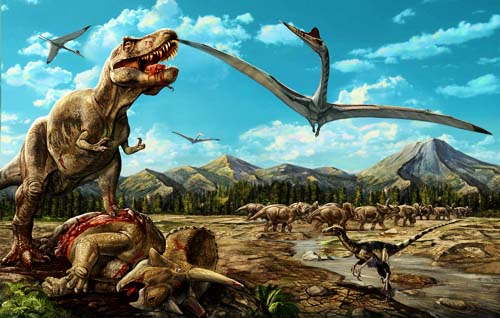Keeping this predator airborne at altitudes as high as 10,000 feet
将庞大的身躯保持在一万英尺的高空
requires a 12-meter wingspan, an accurate guidance system, and near-perfect eyesight.
需要12米的翼展精确的导航系统和超常的视力。
What we see is an enlarged eyeball, an enlarged eye socket, and the processing centers of the brain,
我们看到的是巨大的眼球和眼窝大脑的运算中心,
the optic lobes, were also very much expanded.
视叶也都是非常庞大的。
Its four-inch retina is packed with over a billion light receptors and registers
四英寸大的视网膜布满过十亿个光束接收器和记录器,
as much as four times the detail of the human eye.
是人眼精细程度的四倍。
A Quetzalcoatlus can also see a spectrum of light invisible to humans...ultraviolet.
风神翼龙也能看到人类看不到的光紫外线。
The urine of their prey absorbs U.V. rays and then reflects them back.
猎物的尿液会吸收并反射紫外线。

This creates a lighted trail leading straight to their quarry.
风神翼龙依靠这些光线直接追踪到猎物。
These animals had very highly developed gaze stabilization mechanisms,
它们拥有高度发达的凝视稳定机制,
allowing to keep their target fixed and in focus, within the cross hairs, if you will, as they were moving through space.
使它们在飞行过程中能精准地将目标锁定在它们的十字准线之内。
The secret to gaze stabilization is hidden in the inner ear.
如此稳定的凝视能力,其奥秘在于它的内耳。
Three interconnected tubes form what are called semicircular canals.
三个互相连通的软管构成内耳半规管。
Fluid fills each canal, and small hairs detect the tiniest movement.
每个半规管中都充满液体细小的绒毛,可感应到极微弱的变动。
As a Quetzalcoatlus' head moves during flight, signals are sent directly to the eye muscles.
风神翼龙在飞行中转动头部时眼部肌肉直接接收信号。
The eyeballs adjust, keeping an image fixed and perfectly in focus.
眼球迅速调整继续精准地盯住猎物。
From 300 meters in the air, a Quetzalcoatlus can pick out a T. Rex nest and even count the number of chicks.
在300米的高空中风神翼龙就能找出雷克斯霸王龙的巢穴甚至数清有几只幼龙。
I think that a big pterosaur on the ground would've been spooky because they would be moving around on all fours.
翼龙在地面上看起来一定很吓人。因为它们用四肢行走。
They'd probably have those sort of quick, precise movements like birds, but they'd be huge.
它们像鸟类一般行动迅速而灵敏,但体型却比鸟类庞大。



